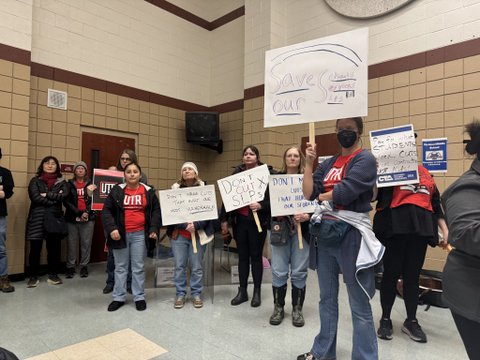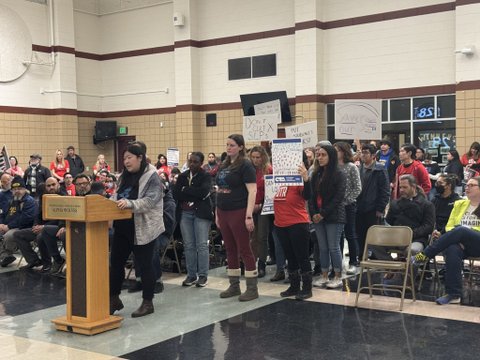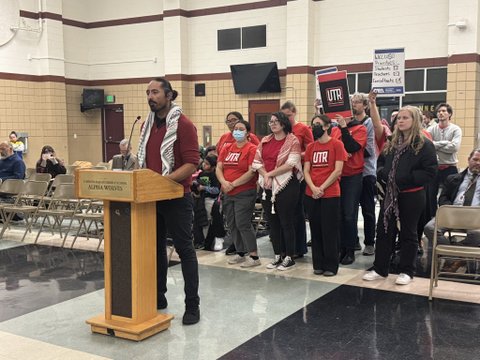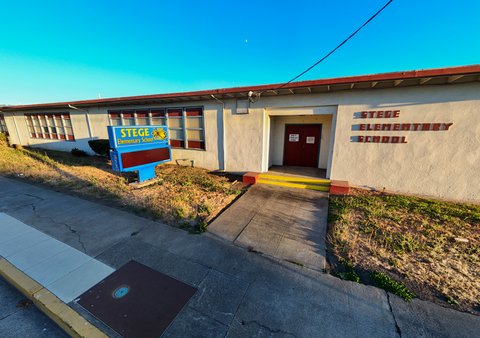
14 Feb EdSource: West Contra Costa Community Rallies Around Educators Protesting Staff Cuts

United Teachers of Richmond gather at West Contra Costa school board meeting Wednesday to protest staff cuts approved a week earlier.
Story and photos by Monica Velez, EdSource
San Pablo mom Gabriella Garcia said her fourth-grade son sometimes comes home in tears after being bullied about his speech impediment.
Her son receives help through Zoom calls with a speech specialist.
“Unfortunately, I don’t think this virtual format is effective for him,” Garcia said. “He continued to struggle with pronunciation, and it’s been tough for him.”
Garcia pleaded with the West Contra Costa Unified school board on Wednesday night to stop cutting staff, including speech specialists, so her son and others like him can continue getting the hands-on support they need.
Her son’s teacher at Lake Elementary School, Christina Baronian, said she and the other students often have difficulty understanding him and that the only support available is online and through a contractor.
“It’s awful,” Baronian said during public comments. “It’s not giving him the support he needs; he needs an in-person speech therapist. Then I found out (the district) just cut some of the very few in-person (speech therapists) we have. This is his right. This is his future.”
The United Teachers of Richmond also gathered at Wednesday night’s board meeting to protest the $13 million in budget cuts the board approved one week ago, saying the cuts are “unnecessary,” “harmful” and “devastating” to students. The $13 million in cuts will be spread over the next two school years.
“We greatly appreciate the dedicated staff who continually serve our students and community,” interim Superintendent Kim Moses said in a statement to EdSource. “Although reductions are necessary, we are taking great care to address these reductions with minimal impact on staff and students.”
More than 60 West Contra Costa Unified School District educators showed up in person and virtually to urge the board to reconsider the fiscal solvency plan it passed. For nearly two hours, almost every speaker asked the board to reconsider the cuts. Union members wore matching red shirts, held up signs, and cheered after every public comment.
Community members at Wednesday’s board meeting chanted “revote” throughout the meeting.
- A speech-language pathologist and member of United Teachers of Richmond addresses the West Contra Costa school board during Wednesday’s meeting to protest the staffing cuts the board approved one week prior, which included speech specialists.
“We are urging the board to keep our schools stable,” said United Teachers of Richmond President Francisco Ortiz. “This is going to have a destabilizing effect, and they (the board) have the authority to (avoid cutting staff).”
West Contra Costa Unified School District officials have said that to stay afloat, they need to cut a total of $32.7 million in funds between 2024 and 2027. The bulk of those cuts, $19.7 million, were slashed from the current school year’s budget.
Declining enrollment, expiration of COVID-19 relief funds, increased costs for special education programs, and underfunded mandates from state and federal governments left West Contra Costa strapped for cash, according to district officials. These struggles are being felt across the state, including nearby districts in San Francisco and Oakland which are grappling with budget cuts, school closures and consolidations.
Meanwhile, the California Teachers Association last week launched a statewide campaign called We Can’t Wait, uniting teachers in 32 school districts to leverage their administrations for higher pay and benefits, smaller class sizes, and mental health support. As part of the campaign, more than 100 San Francisco, Oakland, Berkeley and Richmond educators rallied in a downpour in front of Oakland City Hall.
Will the board revote?
No board member has indicated any plan to call for another vote on the budget.
Board members Leslie Reckler, Cinthia Hernandez, and Guadalupe Enllana voted for the plan. Jamela Smith-Folds abstained, and Demetrio Gonzalez-Hoy was absent.
“These reductions are not secret,” board President Reckler wrote in an email to EdSource. “They are part of a years-long public fiscal solvency plan that was approved by the Contra Costa County Office of Education. Further, Labor has worked alongside board members and staff to identify reductions. These reductions are necessary to align adults to declining student counts.”
West Contra Costa has faced challenging budget deficits before. In 1991, the district became the first in the state to go insolvent and received a $29 million bailout loan, which took 21 years to pay off.
Board member Gonzalez-Hoy said in a statement that the district needs to stop concentrating on what to cut and begin focusing on where it needs to invest and how to bring in more revenue. He added that resources should be put into increasing enrollment, daily attendance and growing programs. He said he will ask the board president to form a task force to address these issues.
>>>Teacher and Her Students Agree: Layoffs Not the Answer to WCCUSD Budget Woes<<<
“We as a whole spend more time getting rid of what is broken instead of trying to fix it,” Gonzalez-Hoy said. “If we just keep concentrating on cuts and reduction, eventually we will disappear. We are deeply divided as a community, and it is time for us to come together for the future of our students.”
West Contra Costa is not currently considering school closures or consolidations, trustee Hernandez said in an emailed statement.
“As a board member, I deeply understand the profound impact these financial challenges have on our school community and the urgent need for essential services that may no longer be available,” Hernandez said. “These are difficult choices, and none were made lightly. However, our priority remains securing a fiscally responsible path forward that allows us to continue serving our students effectively.”
Vacancies and staffing cuts
Emilia Calderón teaches math at Richmond High School, and she said she constantly has to sub for other classes during her free period because of the high number of vacancies.
“Every year, they cut teachers, and even though we are lacking teachers, they (the district) still cut teachers,” she said. “And so I’m subbing for classes with vacant positions, and then it feels ridiculous to have them turn around and say, ‘We’re going to cut more teachers.’ How does that make sense?”
Over the next two school years, about 1.6% of the United Teachers of Richmond staff will be let go for a total savings of about $3.7 million, including teachers, social workers, speech therapists and assistant principals.
But with looming cuts, students and staff have also felt the weight of having longtime vacancies. How do these exist at the same time? It’s a question the teachers union and community has been grappling with, Ortiz said.
- Francisco Ortiz, United Teachers of Richmond president, addresses the West Contra Costa school board on Wednesday during public comment to protest the staffing cuts the board approved one week prior.
West Contra Costa’s fiscal solvency plan uses multiyear projections based on fully-staffed schools, Ortiz said, which is about 1,600 educators. Currently, there are about 130 vacant positions, which is equivalent to nearly $19 million, he said.
“It creates this crisis that we have to reduce, but we don’t have fully staffed people,” Ortiz said. “If we had a fully staffed school district, then that could potentially make sense, but we don’t have a fully staffed school district.”
But Moses said that when there are vacant positions, the district still needs to pay for substitutes, overtime or contractors to cover services.
“These replacement costs offset the salaries that have been set aside for the vacant positions,” Moses said. “Due to current vacancy levels, we expect that there will be a certificated job available for all current WCCUSD educators for the 2025-26 school year.”
The deadline for the district to send layoff notices is March 15.
“A lot of the folks we have in our district, they’re either homegrown or they choose to come here,” Ortiz said, referring to district educators. “We want to provide them with an incentive to stay in our district, and we’re currently not doing that with these haphazard or ill-conceived moves.”
But in the meantime, the educators who are choosing to stay in West Contra Costa are trying to help students in ways they weren’t trained to.
“We not only provide curriculum and teaching, but we’re literally like their parents sometimes and emotional support,” Calderón said. “Since they’re cutting all these social workers, guess who gets the brunt of that emotional support? I try my best, but I’m not a therapist, and it’s quite honestly dangerous to try and have a math teacher be a kid’s therapist.”








No Comments